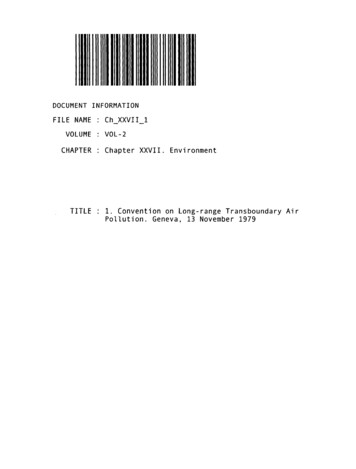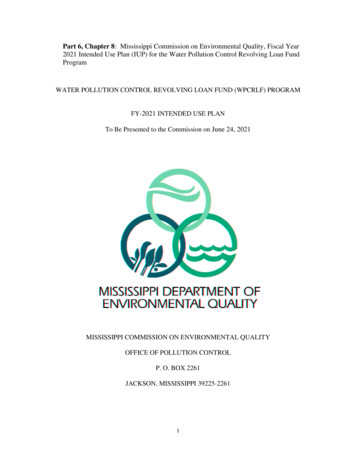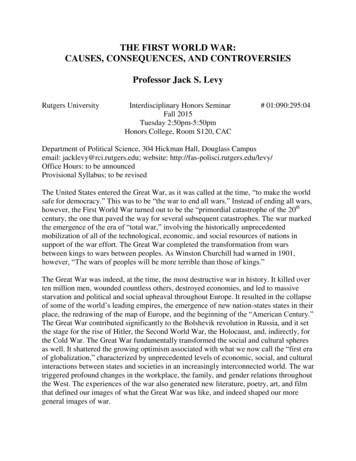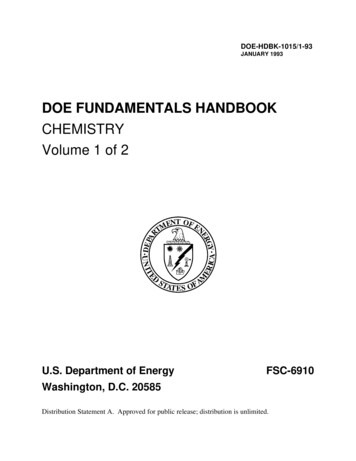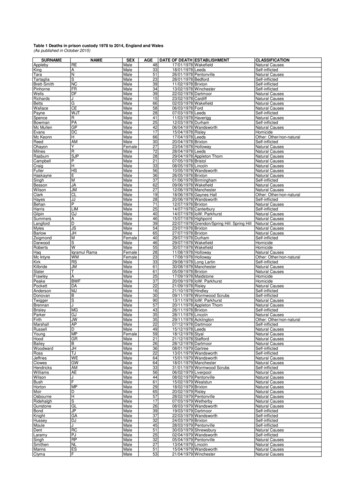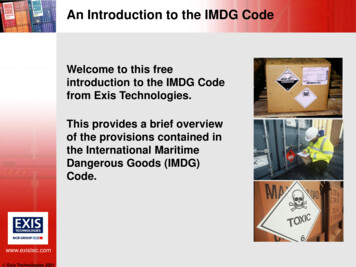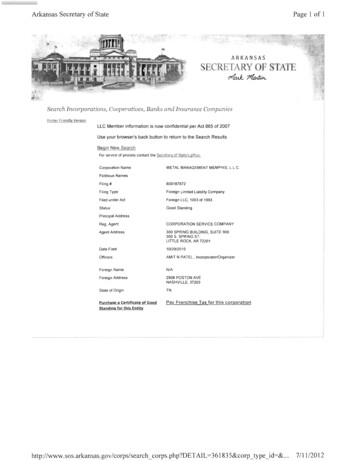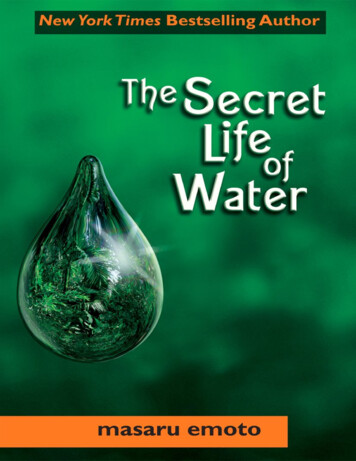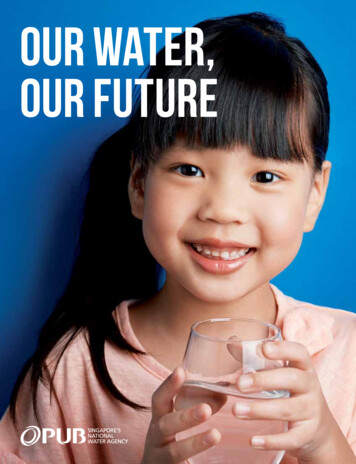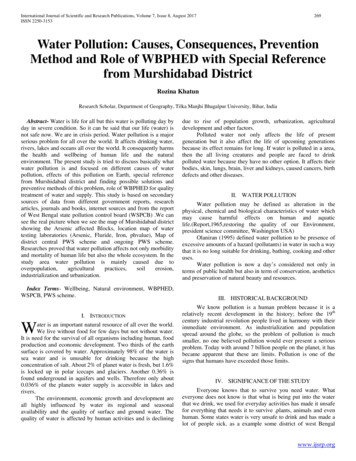
Transcription
International Journal of Scientific and Research Publications, Volume 7, Issue 8, August 2017ISSN 2250-3153269Water Pollution: Causes, Consequences, PreventionMethod and Role of WBPHED with Special Referencefrom Murshidabad DistrictRozina KhatunResearch Scholar, Department of Geography, Tilka Manjhi Bhagalpur University, Bihar, IndiaAbstract- Water is life for all but this water is polluting day byday in severe condition. So it can be said that our life (water) isnot safe now. We are in crisis period. Water pollution is a majorserious problem for all over the world. It affects drinking water,rivers, lakes and oceans all over the world. It consequently harmsthe health and wellbeing of human life and the naturalenvironment. The present study is tried to discuss basically whatwater pollution is and focused on different causes of waterpollution, effects of this pollution on Earth, special referencefrom Murshidabad district and finding possible solutions andpreventive methods of this problem, role of WBPHED for qualitytreatment of water and supply. This study is based on secondarysources of data from different government reports, researcharticles, journals and books, internet sources and from the reportof West Bengal state pollution control board (WSPCB) .We cansee the real picture when we see the map of Murshidabad districtshowing the Arsenic affected Blocks, location map of watertesting laboratories (Arsenic, Fluride, Iron, phvalue), Map ofdistrict central PWS scheme and ongoing PWS scheme.Researches proved that water pollution affects not only morbidityand mortality of human life but also the whole ecosystem. In thestudy area water pollution is mainly caused due ,industrialization and urbanization.Index Terms- Wellbeing, Natural environment, WBPHED,WSPCB, PWS scheme.I. INTRODUCTIONWater is an important natural resource of all over the world.We live without food for few days but not without water.It is need for the survival of all organisms including human, foodproduction and economic development. Two thirds of the earthsurface is covered by water. Approximately 98% of the water issea water and is unusable for drinking because the highconcentration of salt. About 2% of planet water is fresh, but 1.6%is locked up in polar icecaps and glaciers. Another 0.36% isfound underground in aquifers and wells. Therefore only about0.036% of the planets water supply is accessible in lakes andrivers.The environment, economic growth and development areall highly influenced by water its regional and seasonalavailability and the quality of surface and ground water. Thequality of water is affected by human activities and is decliningdue to rise of population growth, urbanization, agriculturaldevelopment and other factors.Polluted water not only affects the life of presentgeneration but it also affect the life of upcoming generationsbecause its effect remains for long. If water is polluted in a area,then the all living creatures and people are faced to drinkpolluted water because they have no other option. It affects theirbodies, skin, lungs, brain, liver and kidneys, caused cancers, birthdefects and other diseases.II. WATER POLLUTIONWater pollution may be defined as alteration in thephysical, chemical and biological characteristics of water whichmay cause harmful effects on human and aquaticlife.(Report,1965,restoring the quality of our Environment,president science committee, Washington USA)Olaniran (1995) defined water pollution to be presence ofexcessive amounts of a hazard (pollutants) in water in such a waythat it is no long suitable for drinking, bathing, cooking and otheruses.Water pollution is now a day’s considered not only interms of public health but also in term of conservation, aestheticsand preservation of natural beauty and resources.III. HISTORICAL BACKGROUNDWe know pollution is a human problem because it is arelatively recent development in the history; before the 19thcentury industrial revolution people lived in harmony with theirimmediate environment. As industrialization and populationspread around the globe, so the problem of pollution is muchsmaller, no one believed pollution would ever present a seriousproblem. Today with around 7 billion people on the planet, it hasbecame apparent that these are limits. Pollution is one of thesigns that humans have exceeded those limits.IV. SIGNIFICANCE OF THE STUDYEveryone knows that to survive you need water. Whateveryone does not know is that what is being put into the waterthat we drink, we used for everyday activities has made it unsafefor everything that needs it to survive ,plants, animals and evenhuman. Some states water is very unsafe to drink and has made alot of people sick. as a example some district of west Bengalwww.ijsrp.org
International Journal of Scientific and Research Publications, Volume 7, Issue 8, August 2017ISSN 2250-3153,water is very unsafe to drink and caused water borne diseaseslike ------------Blackfoot, Flurosis, Cholera, Jaundice, Diarrhea,Tuberculosis etc. Now the big question is Why are we pollutedthis natural resource which is very important to all livingorganisms and every section of our life. In this paper I plan toinform that some suggestive solution is help to prevent from thiscontinuing issues and playing role of public health department,Govt of west Bengal for safe drinking water supply andtreatment.V. AIMS AND OBJECTIVES1. To explain and represent water pollution condition andcauses of the study area.2. To discuss how it effects on human being as well as allthe living organisms and natural environment.3. Point out method and prospects of this major problemapplied in the study Area.4. Draw playing role of agencies like WBPHED for safedrinking water supply and treatment and secure drinking waterfor future.VI. HYPOTHESIS FORMULATIONThe work has been done with these hypotheses. Theseare— What is water pollution and main causesof that kind of pollution Water Pollution related consequencesand prevention method Role of WBPHED as a supplier of safedrinking water in Rural and Urban areasVII. REVIEW OF LITERATUREPlace and warfare (1993) argued that the most importantand immediate consequence of environmental degradation in thedeveloping world take the form of damage to human health.According to Chapman (1996) pollution of the aquaticenvironment refers to the introduction by man directly and270indirectly and it effects as harm to living resources, hazards tohuman health, hindrance to aquatic activities including fishing,impairment of water quality with respect to its use in agricultural,industrial and often economic activities and reduction ofamenities.Haque at .al (1998) in the study “surface water pollutionconcern in public health perspectives of Bangladesh.” Discussthe sources and impact of water pollution in Bangladesh.According to Wolf (1999), when significant improvementsin the quality and quantity of water are made in less developedcountries, the world be about 2 million fewer deaths fromDiarrhea among children.Down to Earth magazine reveals that pollution level arerising in the river Lidder ,Pahelgam, the base camp of pilgrimsgoing to Amarnath cave in Jammu and Kashmir .Pilgrims are themajor polluters of the river and they were generating tones ofwaste everyday and also sewage everyday and open drains areresponsible for water pollution in Lidder river.Totazada (2001),in the study “the Chapala lake in Mexico“ reveals the major sources of water pollution in Mexico, majorpollutants of the lake are municipal ,industrial and agriculturalrunoff.VIII. STUDY AREAMurshidabad district is northern most district of thepresidency division of west Bengal. It lies centrally in the lowerGanga valley.The geographical extension of the district is 24⁰50 20”-23⁰43 30”N and 88⁰46 00”- 87⁰49 17” E. With the area of5324 sq.km. The district is separated from Malda by the riverGanga on its north. The pear shaped district looked like antriangle with Farakka block in the north west framing apex. Onthe west by the district of Birbhum, on the south by Burdwan andNadia and on the East by Bangladesh.Water pollution is one of the major problems ofMurshidabad. Murshidabad district has worst affected byArsenic. Most of the Block of Murshidabad district had highamount of Arsenic (Suti-1, suti-2, Domkal, Raghunathganj andHarihrpara). Only name of the block Bharatpur- II is safe fromArsenicwww.ijsrp.org
International Journal of Scientific and Research Publications, Volume 7, Issue 8, August 2017ISSN 2250-3153271LOCATION MAP OF THE STUDY AREA: MURSHIDABADIX. DATABASE AND METHODOLOGYThe research work is descriptive and analytical in nature.This study is based on mainly secondary sources of data.Secondary data are collected from different government reports,research articles, journals and books, internet sources and fromthe report of WSPCB (West Bengal state pollution controlboard).Using map of Murshidabad districts arsenic affectedblocks, showing location map of water testing laboratories andmap of central water supply scheme and ongoing PWS scheme inMurshidabad district managed by PHED.X. CAUSES OF WATER POLLUTIONPollution of water are the results of various causes. Thereare three major sources of pollutants of water-Home, Agriculture,Industry. In the study area water pollution caused mainly fromhome and agriculture rather than industry.*high population density (According to 2011 census the districthas a population density of 1334 inhabitants per squarekilometer)*Pollution of ground water through drilling activities*Industrial waste dumped into water (industrial waste isextremely harmful to both people and environment)*Sewage leakages*Flooding during rainy season which carries waste deposits intowater (It happen mainly river Ganga in the study area)*Heavy metal*Toxic waste disposal at river*Soil digging inside river area (that is the major point of thestudy area for water pollution)*Eroded cides and fertilizer*Using HYV seed Eutrophication (Eutrophication is an increased level of nutrientsin water bodies. This results in bloom of Algae in Water. It alsodepletes the oxygen in water, which negatively affects fish andother aquatic animal population)*Failing septic system*Household chemicals (Dishwashing waste, laundry waste)*Animal waste*Heat(Industrial areas hot water mixed into cold water andpolluted example, saw it at Farakka thermal power projectareas hot water mixed into Fider canal water)XI.EFFECTS OF WATER POLLUTIONWater pollution adversely affects the health and life ofman, animals and plants. Polluted water is also harmful foragriculture as it adversely affects the crops and the soil fertility** Health aspects of water quality (Spread of disease: Cholera,Typhoid, Diarrhea, Jaundice and Tuberculosis)**Affect body organs: injury to the heart and kidneyswww.ijsrp.org
International Journal of Scientific and Research Publications, Volume 7, Issue 8, August 2017ISSN 2250-3153** Effects of nutrients on water quality (Harms the food chain:polluted water can harm aquatic organisms thus breaking a linkof food chain)** Effect of organic pollution on water quality-(Causes Algae inwater: algae grow according to how much waste in a watersource .Bacteria feed off the algae, decreasing the amount ofoxygen in water and this incident harm organisms)**Flooding**Harms animal**Harms all leaving organisms Effect of High Dissolved Solids (TDS) in water quality(hamper aquatic ecosystem) Thermal discharges on water quality (physiologically stressfor organisms)XII. STEPS TO PREVENT WATER POLLUTIONWater pollution has a huge impact in our lives. Withknowledge consideration and preparation, water pollution can bedecreased. It does not take much effort-just a little thought. Use fewer chemicals to clean your home(EPAprovides a list of cleaning products) Dispose of waste properly Don t flush medication Don t flush trash Conserve as much water as possible Avoid using plastic Recycling and Reuse of water Don t use pesticides and herbicides Removed concrete surfaces and replace themwith ground cover Prevent soil erosion from occurring Clean up waterways Inspects your septic system every 3-5 years Don t wash paint brushes in the sink Get involved at school and work Help clean up litter in water filled areas Speak up about water issues that affect yourcommunity Making Swachh Bharat Abhiyan a success Finally Enforcing Laws to prevent waterpollution272Water pollution, and for the maintaining or restoring ofWholesomeness of water in the country. The act was amended in1988. In India CPCB (central pollution control board) play animportant role for prevention of water and control of pollution).XIV. ROLE OF WBPHEDPublic Health Engineering Department Government ofWest Bengal, their vision to provide safe, sustainable andadequate water supply to all human and livestock in west Bengalin between 2020.PHD first established and began their work in1987.Their objectives are(i) To ensure safe and permanent drinking water security(ii) To supply water door to door (rural area also) throughPWS-pipeline water supply scheme(iii) Also aware people about conjunctive use of groundwater, surface water and rain water harvesting(iv) Check standarity of water at both the supply andconsumption points.XV. WORKPLAN OF WBPHED1. Resource creation: i. using subsurface flow of a river, ii.Using ground water, iii. Flood water diversion and storage, iv.Rejuvenation of ponds and development of watershed, v.Developing cheaper solution for treatment of water, rooftop rainwater harvesting.2. .Action plan to use renewable energy for running watersupply scheme3.Action on management of waste water treatment plant4. Water quality monitoring and surveillance programme5.Peoples participation: (work 2 organization, SWSSOstate water and sanitation support organization, SWSM-statewater and sanitation mission).XVI. WBPHED: WATER TESTING LABRATORYWater quality is very poor in some blocks of Murshidabad.Most of the water polluted by Arsenic. Some water testinglaboratories are situated in Murshidabad district managed byPHED and their treatment parameters are Arsenic, Iron andFluoride.XIII. THE WATER CONTROL OF POLLUTION ACTThe water (prevention and control of pollution) Act wasenacted in 1974 to provide for the prevention and control ofwww.ijsrp.org
International Journal of Scientific and Research Publications, Volume 7, Issue 8, August 2017ISSN 2250-3153273WATER TESTING LABRATORIES LOCATIONMAP: 1SOURCE: WBPHEDXVII. NAME SOME LABRATORIES(1)Baharampur municipal division(2) Jagatai W/S scheme (3) Hariharpara W/S scheme (4) Islampur sub division office (5)Jalangi W/S scheme (6) Jangipur WTP Site (7) Joykrishnapur W/ S scheme (8) Lalbagh sub division office (9) Mahyampur WTP site(10) Murshidabad district lab (11) Rejinagar W/S scheme (12) Sagardighi W/S scheme(13) Salar W/S scheme.www.ijsrp.org
International Journal of Scientific and Research Publications, Volume 7, Issue 8, August 2017ISSN 2250-3153274CENTRAL SECTOR WATER PROJECT 1 - MURSHIDABADMAP-2SOURCE: WBPHEDwww.ijsrp.org
International Journal of Scientific and Research Publications, Volume 7, Issue 8, August 2017ISSN 2250-3153275CENTRAL SECTOR WATER PROJECT 2- MURSHIDABADMAP-3SOURCE: WBPHEDMurshidabad central sector water project are two numbers,managed by PHED. One is –sector pt 1, developed withMurshidabad, Jiaganj and Berhampur by surface water of riverBhagirathi, covered 135 villages and benefited people 379692.Another one is –sector pt 2, developed with Hariharpara andBerhampore by surface water of river Bhagirathi, covered 105villages and benefited people 659684.XVIII. ONGOING PWSS SCHEME BY PHEDOngoing PWS (pipeline water supply scheme) scheme isdeveloped in Beldanga by surface water of river Bhagirathi,covered 58 villages, and benefited people 754451.www.ijsrp.org
International Journal of Scientific and Research Publications, Volume 7, Issue 8, August 2017ISSN 2250-3153276BELDANGA PWS SCHEMEMAP: 4SOURCE: WBPHED[2]XIX. CONCLUSIONFrom the above discussion we have concluded that due toincrease in population and agricultural practice and alsoindustrialization ,water quality of drinking water is decrease andthere a need to proper treatment of water and some preventionmethod to reduce water pollution and manage to supply safedrinking water. And there is a big hope in Murshidabad districtsto supply safe drinking water , door to door in rural areas byPWS/WS scheme which managed by WBPHED. At the sametime government introduce Environmental Education in schoolsyllabus, which raise awareness and government of west Bengalmade the subject compulsory in school and college level. Finallywe can say” SAFE WATER, SAVE LIFE.”REFERENCES[1]OWA, F.D,”Water pollution: sources, effects, control and management”MCSER, volume 4,no 8; Sept-2013 ISSN 2039-2117Patil,R.B(2009),Environment in Indian society, problems and prospects ,AMittal publication, New Delhi(India).[3] APEC, (2015), the importance of water and your health .Free drinkingwater.[4] Http//project smile india.wordpress.com/2010/07/01/effect of waterpollution solutions.[5] Dr .Mukesh Garg (2012)”Water pollution in India: causes and remedies”,Vol-2, No-6, June, ISSN 2249-5894.[6] Ahmed, M and Rahaman, M (2000),”water supply and sanitation”.[7] Drinking water and sanitation status, Water Air[8] Public Health Engineering Department, Government of West Bengal, vision-2020.[9] Singh, Savindra (2011),”Environmental Geography”, page no.485[10] Joshua Nizel Halder and M Nazmul Islam(2015),”Water pollution and itsimpact on human health” ,Volume -2 ,No-1,ISSN 2373-8324.AUTHORSFirst Author – Rozina Khatun, rozinakhatun1@gmail.com,Mobile No. 7384968377, Research Scholar, Department OfGeography, Tilka Manjhi Bhagalpur University, Bihar, Indiawww.ijsrp.org
International Journal of Scientific and Research Publications, Volume 7, Issue 8, August 2017ISSN 2250-3153277www.ijsrp.org
study area water pollution is mainly caused due to overpopulation, agricultural practices, soil erosion, industrialization and urbanization. Index Terms- Wellbeing, Natural environment, WBPHED, WSPCB, PWS scheme. I. INTRODUCTION ater is an important natural resource of all over the world.
